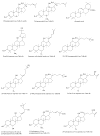Current evaluation of the millennium phytomedicine- ginseng (II): Collected chemical entities, modern pharmacology, and clinical applications emanated from traditional Chinese medicine
- PMID: 19689273
- PMCID: PMC2754208
- DOI: 10.2174/092986709788803204
Current evaluation of the millennium phytomedicine- ginseng (II): Collected chemical entities, modern pharmacology, and clinical applications emanated from traditional Chinese medicine
Abstract
This review, a sequel to part 1 in the series, collects about 107 chemical entities separated from the roots, leaves and flower buds of Panax ginseng, quinquefolius and notoginseng, and categorizes these entities into about 18 groups based on their structural similarity. The bioactivities of these chemical entities are described. The 'Yin and Yang' theory and the fundamentals of the 'five elements' applied to the traditional Chinese medicine (TCM) are concisely introduced to help readers understand how ginseng balances the dynamic equilibrium of human physiological processes from the TCM perspectives. This paper concerns the observation and experimental investigation of biological activities of ginseng used in the TCM of past and present cultures. The current biological findings of ginseng and its medical applications are narrated and critically discussed, including 1) its antihyperglycemic effect that may benefit type II diabetics; in vitro and in vivo studies demonstrated protection of ginseng on beta-cells and obese diabetic mouse models. The related clinical trial results are stated. 2) its aphrodisiac effect and cardiovascular effect that partially attribute to ginseng's bioactivity on nitric oxide (NO); 3) its cognitive effect and neuropharmacological effect that are intensively tested in various rat models using purified ginsenosides and show a hope to treat Parkinson's disease (PD); 4) its uses as an adjuvant or immunotherapeutic agent to enhance immune activity, appetite and life quality of cancer patients during their chemotherapy and radiation. Although the apoptotic effect of ginsenosides, especially Rh2, Rg3 and Compound K, on various tumor cells has been shown via different pathways, their clinical effectiveness remains to be tested. This paper also updates the antioxidant, anti-inflammatory, anti-apoptotic and immune-stimulatory activities of ginseng, its ingredients and commercial products, as well as common side effects of ginseng mainly due to its overdose, and its pharmacokinetics.
Figures
References
-
- Jiang JW, Xiao QS. Handbook of active constituents of medicinal plants. People’s Health Publisher; Beijing: 1985. pp. 503–516.
-
- Park EK, Shin YW, Lee HU. Inhibitory effect of ginsenoside Rb1 and compound K on NO and prostaglandin E2 biosynthesis of RAW264.7 cells induced by lipopolysaccharide. Bio Pharm Bull. 2005;28:652–656. - PubMed
-
- Lee YJ, Jin YR, Lim WC. Ginsenoside-Rb1 acts as a weak phytoestrogen in MCF-7 human breast cancer cells. Arch Pharm Res. 2003;26:58–63. - PubMed
-
- Fujimoto J, Sakaguchi H, Aoki I. Inhibitory effect of ginsenoside-Rb2 on invasiveness of uterine endometrial cancer cells to the basement membrane. Eur J Gynecol Oncol. 2001;22:339–41. - PubMed
-
- Liu ZQ, Luo XY, Sun YX. Can ginsenosides protect human erythrocytes against free-radical-induced hemolysis. Biochim Biophys Acta. 2002;1572:58–66. - PubMed
Publication types
MeSH terms
Substances
Grants and funding
LinkOut - more resources
Full Text Sources
Medical
Miscellaneous


